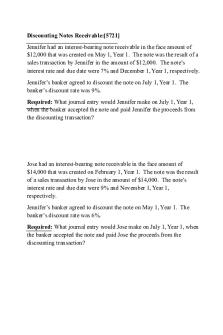Discounting - summary PDF

| Title | Discounting - summary |
|---|---|
| Course | Basic Accounting |
| Institution | Notre Dame University |
| Pages | 3 |
| File Size | 42.3 KB |
| File Type | |
| Total Downloads | 18 |
| Total Views | 145 |
Summary
summary...
Description
Discounting of Notes Receivable (Summary)
Another form of receivable financing is discounting of notes receivable. The holder endorses the note to the bank in exchange for maturity value of the note less a discount. The bank collects the maturity value of the note from the maker. Note be discounted with or without recourse. Discounting With Recourse In case if the maker fails to pay, the holder is held liable. The note discounted is not derecognized. The discounting is accounted for in either: o
Conditional sale of note receivable- contingent liability equal to face amount of the note discounted is disclosed only in the notes to financial statements Entry to record discounting: Cash on Hand
xx
Loss on Discounting
xx
Note Receivable Discounted
xx
Interest Income
xx
Entry to record collection: Note Receivable Discounted
xx
Note Receivable o
xx
Secured borrowing- liability equal to the face amount of the note discounted is recognized on the discounting Entry to record discounting: Cash on Hand
xx
Interest Expense
xx
Liability on Note Discounted
xx
Interest Income
xx
Entry to record collection: Liability on Note Discounted Note Receivable
Maturity Value = Principal + Interest for the full term of note
xx xx
Discount Period = Full Term – Expired Term Discount = Maturity Value × Discount rate × Discount period
Discounting Without Recourse The holder is not held liable in case the maker fails to pay. The note discounted has been sold outright thus derecognized. To record discounting: Cash on Hand
xx
Loss on Discounting
xx
Note Receivable
xx
Interest Income
xx
Formulas to be used: Net Proceeds = Maturity Value – Discount Maturity Value = Principal + Interest for the full term of note Discount = Maturity Value × Discount rate × Discount period o
Discount period- the remaining period to maturity date of note as of date of discounting; unexpired term of the note
o
Discount rate- the rate at which the note is discounted with a bank
o
Interest Income- the accrued interest as of the date of discounting
Dishonoured Notes Note Receivable that are not collected at maturity. When dishonoured, a note loses its negotiable characteristic and becomes an ordinary claim. Transferred from Notes Receivable to Accounts Receivable. Amount transferred is the maturity value of the note plus any costs directly attributable to the dishonour, the receivable is assessed for impairment.
Entry to record dishonoured note: Note Receivable Dishonoured
xx
Note Receivable Accounts Receivable
xx xx
Cash on Hand
xx
Discounting of Own Note When entity borrows money from bank and discounts its own note means that the bank deducted in advance the interest on the loan. Loan proceeds is equal to the principal less the interest deducted in advance.
To record own note discounted: Cash on Hand
xx
Discount on Note Payable
xx
Note Payable
xx...
Similar Free PDFs

Discounting - summary
- 3 Pages

Discounting of Notes(3)
- 7 Pages

Summary
- 4 Pages

Summary
- 42 Pages

Summary
- 43 Pages

- Summary
- 41 Pages

Summary
- 56 Pages

Summary
- 1 Pages

Quicksand Summary
- 3 Pages

Symposium summary
- 2 Pages
Popular Institutions
- Tinajero National High School - Annex
- Politeknik Caltex Riau
- Yokohama City University
- SGT University
- University of Al-Qadisiyah
- Divine Word College of Vigan
- Techniek College Rotterdam
- Universidade de Santiago
- Universiti Teknologi MARA Cawangan Johor Kampus Pasir Gudang
- Poltekkes Kemenkes Yogyakarta
- Baguio City National High School
- Colegio san marcos
- preparatoria uno
- Centro de Bachillerato Tecnológico Industrial y de Servicios No. 107
- Dalian Maritime University
- Quang Trung Secondary School
- Colegio Tecnológico en Informática
- Corporación Regional de Educación Superior
- Grupo CEDVA
- Dar Al Uloom University
- Centro de Estudios Preuniversitarios de la Universidad Nacional de Ingeniería
- 上智大学
- Aakash International School, Nuna Majara
- San Felipe Neri Catholic School
- Kang Chiao International School - New Taipei City
- Misamis Occidental National High School
- Institución Educativa Escuela Normal Juan Ladrilleros
- Kolehiyo ng Pantukan
- Batanes State College
- Instituto Continental
- Sekolah Menengah Kejuruan Kesehatan Kaltara (Tarakan)
- Colegio de La Inmaculada Concepcion - Cebu





